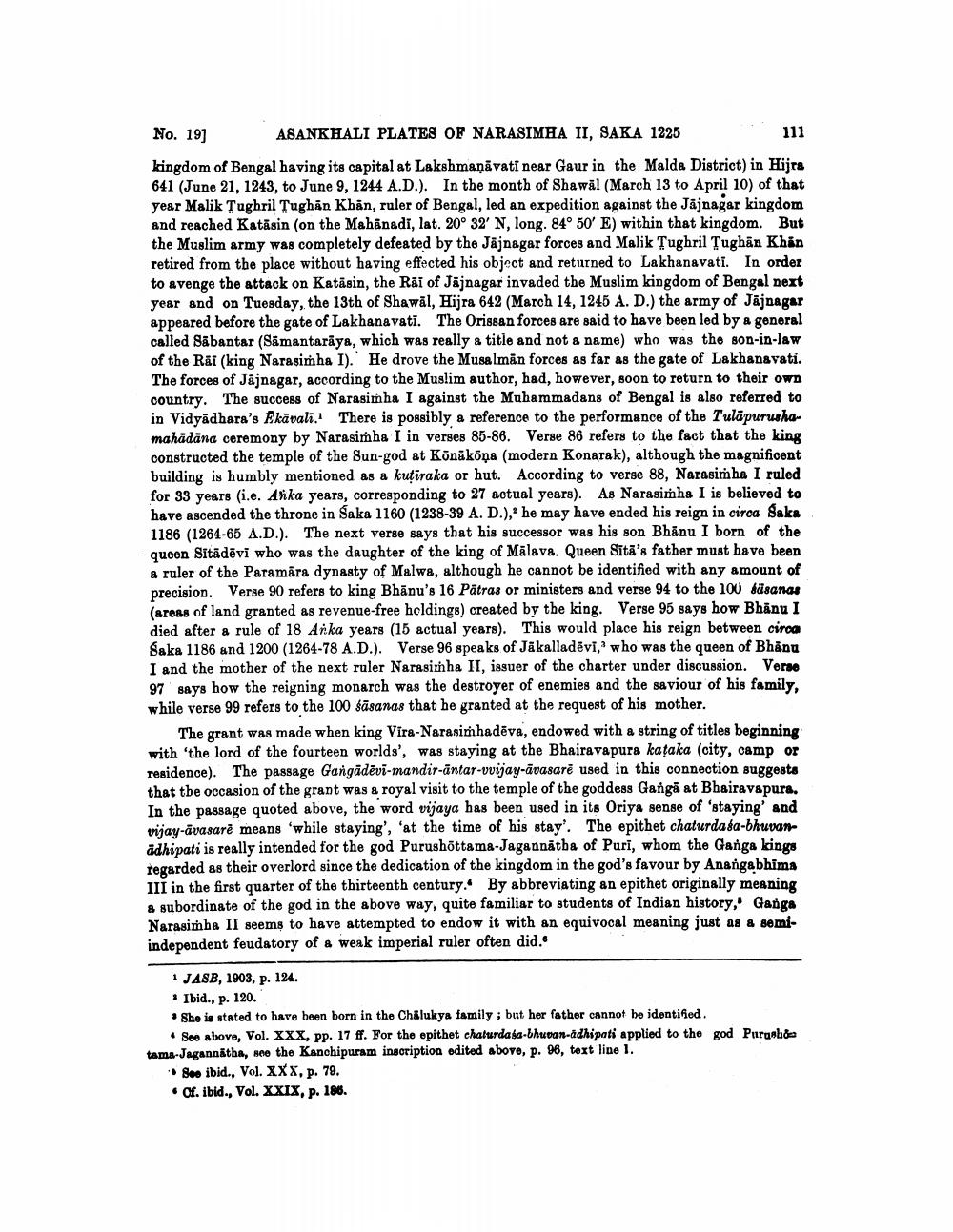________________
111
No. 19) ASANKHALI PLATES OF NARASIMHA II, SAKA 1225 kingdom of Bengal having its capital at Lakshmaṇāvati near Gaur in the Malda District) in Hijra 641 (June 21, 1243, to June 9, 1244 A.D.). In the month of Shawăl (March 13 to April 10) of that year Malik Tughril Тughan Khan, ruler of Bengal, led an expedition against the Jājnagar kingdom and reached Katasin (on the Mahanadi, lat. 20° 32' N, long. 84° 50' E) within that kingdom. But the Muslim army was completely defeated by the Jājnagar forces and Malik Tughril Тughan Khan retired from the place without having effected his object and returned to Lakhanavati. In order to avenge the attack on Katasin, the Rai of Jājnagar invaded the Muslim kingdom of Bengal next year and on Tuesday, the 13th of Shawal, Hijra 642 (March 14, 1245 A. D.) the army of Jäjnagar appeared before the gate of Lakhanavati. The Orissan forces are said to have been led by a general called Sābantar (Samantariya, which was really & title and not a name) who was the son-in-law of the Rai (king Narasimha I).' He drove the Musalman forces as far as the gate of Lakhanevati. The forces of Jājnagar, according to the Muslim author, had, however, soon to return to their own country. The success of Narasimha I against the Muhammadans of Bengal is also referred to in Vidyadhara's Ekävali. There is possibly a reference to the performance of the Tulāpurushamahädäna ceremony by Narasimha I in verses 85-86. Verse 86 refers to the fact that the king constructed the temple of the Sun-god at Könākoņa (modern Konarak), although the magnificent building is humbly mentioned as a kuțiraka or hut. According to verse 88, Narasimha I ruled for 33 years (i.e. Anka years, corresponding to 27 actual years). As Narasimha I is believed to have ascended the throne in Saka 1160 (1238-39 A. D.)," he may have ended his reign in circa Saka 1186 (1264-65 A.D.). The next verse says that his successor was his son Bhanu I born of the queen Sitädēvi who was the daughter of the king of Mālava. Queen Sita's father must have been a ruler of the Paramāra dynasty of Malwe, although he cannot be identified with any amount of precision. Verse 90 refers to king Bhānu's 16 Pätras or ministers and verse 94 to the 100 säsanas (areas of land granted as revenue-free holdings) created by the king. Verse 95 says how Bhanu I died after a rule of 18 Anka years (15 actual years). This would place his reign between circa Saka 1186 and 1200 (1264-78 A.D.). Verse 96 speaks of Jäkalladēvi," who was the queen of Bhanu I and the mother of the next ruler Narasimha II, issuer of the charter under discussion. Verse 97 says how the reigning monarch was the destroyer of enemies and the saviour of his family, while verse 99 refers to the 100 sāsanas that he granted at the request of his mother.
The grant was made when king Vira-Narasimhadēva, endowed with a string of titles beginning with the lord of the fourteen worlds', was staying at the Bhairavapura kataka (city, camp or residence). The passage Gangādēvi-mandir-āntar-vvijay-āvasarë used in this connection suggests that the occasion of the grant was a royal visit to the temple of the goddess Ganga at Bhairavapura. In the passage quoted above, the word vijaya has been used in its Oriya sense of 'staying' and vijay-ävasard means 'while staying', 'at the time of his stay'. The epithet chaturdasa-bhuvan adhipati is really intended for the god Purushottama-Jagannatba of Puri, whom the Ganga kings regarded as their overlord since the dedication of the kingdom in the god's favour by Anangabhima III in the first quarter of the thirteenth century. By abbreviating an epithet originally meaning & subordinate of the god in the above way, quite familiar to students of Indian history, Ganga Narasimha II seems to have attempted to endow it with an equivocal meaning just as & semiindependent feudatory of a weak imperial ruler often did.
1 JASB, 1903, p. 124. * Ibid., p. 120.
She is stated to have been born in the Chalukya family; but her father cannot be identified
• See above, Vol. XXX, pp. 17 ff. For the epithet chaturdasa-bhuvan-adhipati applied to the god Purushda tama Jagannatha, see the Kanchipuram inscription edited above, p. 98, text line 1.
Se. ibid., Vol. XXX, p. 79. • Of. ibid., Vol. XXIX, p. 186.




